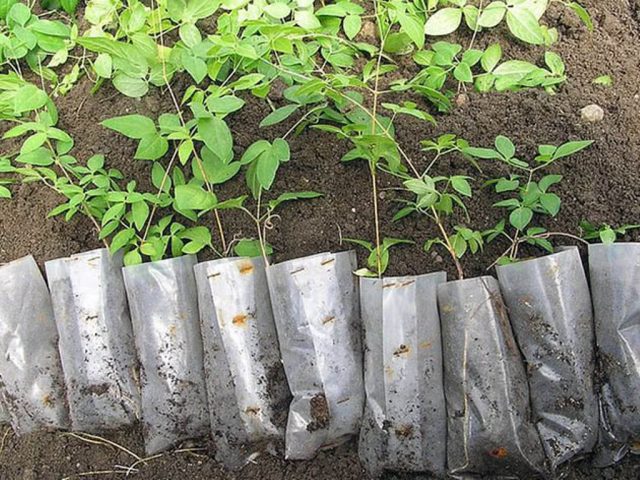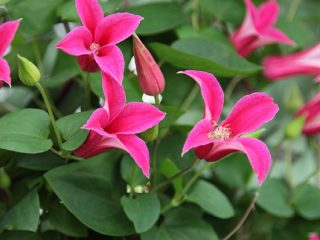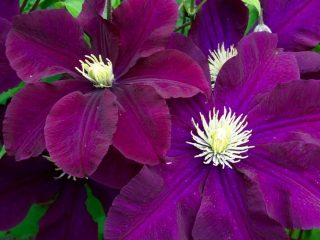Content
Clematis Sunset is a perennial, beautifully flowering vine. In spring, the plant produces bright red flowers that last until the first frost. The plant is suitable for vertical growing. Powerful and flexible stems will easily and in a short time create a green wall strewn with bright large flowers.
Description of clematis Sunset
Clematis Sunset is a perennial, large-flowered hybrid. In regions with warm climates, the loach reaches 3 m. The flexible but strong stem is covered with dark green foliage, small in size. Twice a year, large flowers bloom on the vine, up to 15 cm in diameter. Golden stamens are surrounded by deep pink sepals with a bright purple stripe in the center. The first flowering begins in early summer on last year's stems, the second - in early autumn on the current year's shoots.
With proper autumn pruning, an adult plant tolerates severe frosts well. In winters with little snow, young shoots may freeze, but in the spring the plant quickly recovers.
Clematis Sunset pruning group
Hybrid clematis Sunset belongs to pruning group 2 - flowers appear on the vine 2 times a year. This combined flowering pattern requires two-stage pruning. The first pruning is carried out after the first flowering, removing old shoots along with the fruit. This will allow the young shoots to grow stronger and show new, abundant flowering.
The second pruning is carried out in the fall, before frost. All shoots are cut to ½ length, leaving a vine 50-100 cm long.
Planting and caring for clematis Sunset
Hybrid clematis Sunset is a perennial, unpretentious, large-flowered variety. Planting time depends on the purchased seedling. If the seedling is purchased in a pot, then it can be planted throughout the growing season. If the seedling has open roots, it is better to plant it in the spring before the buds open.
Selection and preparation of a landing site
In order for clematis to show itself in all its glory, you need to choose the right place for planting. Clematis Sunset is grown in a well-lit area, since in the shade the flowering will not be lush or bright. It is also necessary to choose an area protected from drafts. Strong, gusty winds can easily break flexible, fragile shoots.
The soil for planting should be well-drained, light, neutral or slightly acidic. On acidified, highly moist soil, the plant will stop developing and die.Therefore, when groundwater is shallow, clematis Sunset is placed on a hill so that spring meltwater does not lead to rotting of the root system.
If the soil is clayey and depleted, then the following manipulations must be carried out:
- When digging a planting hole, the excavated soil is mixed with rotted compost, sand and peat in a 1:1:1 ratio.
- 250 g of wood ash and 100 g of complex mineral fertilizers are added to the finished earth mixture.
- If the soil is acidified, then add 100 g of slaked lime or dolomite flour.
Seedling preparation
It is better to purchase clematis seedlings of the Sunset variety in a nursery from trusted suppliers. It is advisable to buy the plant at 2-3 years of age. It should have a developed root system and 2 strong shoots.
If the roots of the plant have dried out before planting, you should place clematis Sunset in warm water with the addition of a root formation stimulator for 3 hours.
Before purchasing a Sunset clematis seedling for planting in your summer cottage, you must first familiarize yourself with the description, planting and care rules.
Landing rules
To grow a beautiful, healthy and lush flowering plant, you must follow the planting rules. Step-by-step instructions for planting a Sunset clematis seedling:
- Dig a planting hole measuring 70x70 cm.
- A 15-centimeter layer of drainage (broken brick, pebbles, small expanded clay) is laid at the bottom.
- The hole is filled with nutrient soil and compacted thoroughly.
- A hole the size of the root system is made in the soil.
- The seedling is carefully removed from the pot with a lump of earth and placed in the prepared hole.
- The voids are filled with earth, compacting each layer.
- For a properly planted plant, the root collar should be buried 8-10 cm.
- A support is installed to which the planted seedling is tied.
- The planted plant is watered abundantly, and the soil around the tree trunk is mulched.
To do this, low-growing perennial and annual flowers are planted nearby. The best neighbors will be marigolds and calendula. These flowers will not only save you from drying out the soil and sunburn, but will also protect Sunset from insect pests.
Watering and fertilizing
Since perennial clematis Sunset loves moist soil without stagnant water, watering should be regular. In dry, hot summers, irrigation is carried out 2-3 times a week so that moisture saturates the soil to a depth of 30 cm. At least 10 liters of water are spent on a young plant, and 20-30 liters on an adult bush.
Lush and beautiful flowering cannot be achieved on depleted soil. The first fertilizing is applied 2 years after planting the seedling, 3-4 times a season:
- during the period of active growth - nitrogenous fertilizers;
- during the formation of buds - phosphorus fertilizing;
- after flowering - potash fertilizers;
- 2 weeks before the first frost - complex mineral fertilizers.
Mulching and loosening
After watering, the soil is loosened superficially and mulched. Sawdust, dry leaves, and rotted humus are used as mulch. Mulch will protect the roots from overheating, retain moisture, stop the growth of weeds and act as an additional fertilizer.
Trimming
Since clematis Sunset belongs to pruning group 2, it is pruned 2 times a season. The first pruning is done at the end of June, after flowering. To do this, last year's shoots are shortened by ½ length.
Autumn pruning is carried out a month before the first frost. Young shoots are shortened, leaving 2-4 well-developed buds, and weak, diseased branches are cut to form a stump.
Preparing for winter
Clematis Sunset is a frost-resistant plant. An adult vine, when grown in regions with an unstable climate, can overwinter without shelter. But in order to preserve young seedlings after pruning, they must be prepared for the coming frost 2 weeks in advance. For this:
- The plant is shed generously with warm, settled water.
- The liana is fed with phosphorus-potassium fertilizers.
- The tree trunk circle is covered with sand and ash to a height of 15 cm.
- When the temperature drops to -3 °C, the pruned vine is bent to the ground and covered with dry leaves or spruce branches, covered with a wooden box and covered with roofing felt or agrofibre.
Reproduction
Clematis Sunset can be propagated by cuttings and offsets. The seed method of propagation is not suitable, since with this method of propagation the grown plant will not have maternal resemblance.
Cuttings. Cuttings 5-7 cm long are cut in the fall from a healthy shoot. Each cutting should have 2-3 well-developed buds. Planting material is treated in a growth stimulator and buried 2-3 cm into light, moist soil at an acute angle. The container with the cuttings is transferred to a cool room where the temperature is kept within 0 °C.At the beginning of spring, the container is installed in a warm, well-lit room. With regular watering, the first leaves on the cuttings appear in mid-March. To prevent the plant from wasting energy on growing green mass, the lower leaves must be removed. When the seedlings become stronger and form a powerful root system, they can be transplanted to a permanent location.
Propagation by cuttings is the easiest and most effective way to propagate Sunset clematis.
- In the fall, they choose the strongest and healthiest shoot, which is located next to the ground.
- After removing the foliage, it is placed in a prepared trench to a depth of 5 cm so that the top is located above the ground.
- The shoot is covered with nutritious soil, watered and mulched.
After a year, the branch will give roots and will be ready to be separated from the mother bush.
Diseases and pests
Clematis Sunset is resistant to fungal diseases and is rarely attacked by insect pests. But if agrotechnical rules are not followed, diseases often appear on Sunset clematis, which can be identified from the photo.
- Wither "Wilt". The first signs of the disease are wilted foliage at the tops of the stems. If treatment is untimely, the plant dies. When the first signs are detected, all shoots are cut off at the root, and the trunk circle is shed with a weak solution of potassium permanganate.
- Leaf necrosis – a fungal disease that often appears after flowering. The leaves become covered with a dark brown coating, dry out and fall off. In order not to lose the plant, it is sprayed with a 1% solution of copper sulfate.
- Rust – lumpy orange-colored growths appear on the outside of the leaf. Without treatment, the foliage dries out and falls off, and the shoots become deformed and lose their elasticity.To combat the disease, the plant is treated with broad-spectrum fungicides.
- Nematodes – the pest attacks the root system, which leads to the rapid death of the plant. It is impossible to save the vine; it is dug up and disposed of, and the ground is treated with boiling water or disinfectant solutions.
Conclusion
Clematis Sunset is a perennial, large-flowered vine that does not require careful care and shelter for the winter. In favorable conditions and with proper pruning, the variety blooms 2 times a season, in summer and autumn. Clematis Sunset is suitable for vertical gardening. Thanks to the tall vine, you can decorate unattractive places in your garden.















